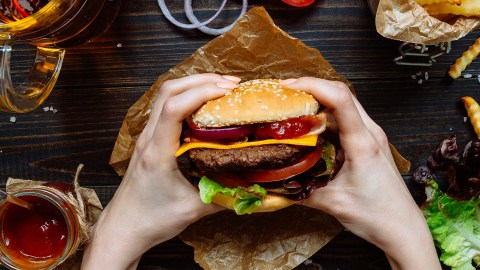Lab-grown meat’s steady march to your plate

Shutterstock
- Just a few years ago, the price of a lab-grown hamburger had five figures.
- Today, that price has gone down to just $11.
- Even if it’s cheap, tastes the same, and preserves the environment, will people actually eat meat grown in a lab?
As 2018 wraps up, the average American is poised to have eaten 222 pounds of beef over the course of the year. Accomplishing this dubious achievement meant that every American ate the equivalent of 2.4 quarter-pound burgers a day. So, we can safely say that Americans like their beef.
The trouble with this, though, is that raising cows for beef production is expensive. A typical ranching operation (although they can vary wildly) costs about $266,630 per year for a 300-head herd, including feed, rented pastures, machinery, and other costs. You can cut down on costs with a factory-farming model, but the increased risk of disease and pollution, and the reportedly cruel nature of factory farms make this less appealing.
Regardless of how beef cows are raised for farming, the environmental impact of cow herds is still problematic. Cow farts and burps might seem like a ridiculous concern at first blush, but they contributed 119.1 million tons of methane to the atmosphere in 2011. And keep in mind, methane is about 30 times as potent as carbon dioxide when it comes to heating up the planet.
But we love beef! Some people can probably be persuaded to go vegetarian, vegan, or simply stop eating beef, but not nearly enough to make the right kind of impact. This begs the question: can we have our beef and eat it too?

In a future where most of us eat lab-grown beef, one has to wonder what would happen to all of the cow herds we currently have. Image source: pxhere.com
The benefits of a lab-cooked meal
Lab-grown beef may very well be the path forward. In 2008, it was estimated that just half a pound of lab-grown beef would cost $1 million. Then, on August 5, 2013, the first lab-grown hamburger was eaten. It cost $325,000 and took two years to make. Just two years later, the same amount of lab-grown beef costs about $11 to make.
Lab-grown beef checks almost all of the boxes: it doesn’t require animal cruelty, and a study in Environmental Science and Technologyshowed that it could cut emissions from conventionally produced meat by up to 96 percent and cut down on the land use required for meat production by 99 percent. In the U.S., where cow pastures take up 35 percent of available land — that’s about 654 million acres — this could be huge. Imagine having 647 million acres for development, housing, national parks, anything at all!
But does lab-grown beef pass the most crucial test? Does it taste like an honest-to-goodness hamburger? After all, if the cost of beef today doesn’t have us converting to vegetarianism in droves, why would we change our behavior for yet another food product that doesn’t quite pack the same umami punch?
The taste test
Well, the 2013 lab-grown burger apparently tasted a bit dry. One taste-tester described it as tasting “like an animal-protein cake.” So, not very appetizing. However, this isn’t a fundamental feature of lab-grown meat, it’s a technical problem. As our techniques have improved, so has the taste of the burger. Today, you can even buy lab-grown meat yourself. Mosa Meats and Memphis Meats both sell artificial meat, and the latter was even funded by Bill Gates.
But even if lab-grown meat tastes like the real thing, there’s still an aversion to the concept. In article for Engadget, one person said “Cultured meat just isn’t normal. […] It’s not. There are all kinds of technical reasons why this is not normal.” Another said she wouldn’t eat lab-grown fish because, “It’s disgusting.”
To be fair, lab-grown meat does conjure up images of tanks full of fleshy material bubbling away, but it’s important to remember that physically, lab-grown beef will be indistinguishable from the real thing. Beef and other meats are a material, like any other, and there’s no reason why the source of this material should affect its nature. And there’s a strong argument to be made that slaughtering cows to harvest their meat is quite a bit nastier than growing meat in a lab — farms are rife with germs that farmers use a panoply of antibiotics to combat them. In a sterile laboratory, this issue wouldn’t be present.

Image source: Shutterstock
How it works
Learning how the meat is actually produced may put some people’s mind at ease. Lab-grown meat starts by taking a small sample of cells from a living cow, so it’s not actually an artificial, synthetic product; it all starts with stem cells from the animal in question. Stem cells differentiate into a variety of cells throughout the body. Most lab-grown meat production uses myosatellite stem cells, which become the various tissues in muscles.
Then, the stem cells are placed in a medium containing a protein that persuades them to turn into muscle tissue rather than anything else, along with the nutrients they need to grow. A cow does the same process, only it eats feedstock and its body turns that into the appropriate nutrients. The sample is placed in a bioreactor similar to those used to make yogurt or beer. A scaffold made out of an edible material is also included to encourage the meat to grow in the right shape.
You let the whole batch cook for a while, and pretty soon, you’ve got ground beef. The question is, will we eat it?





